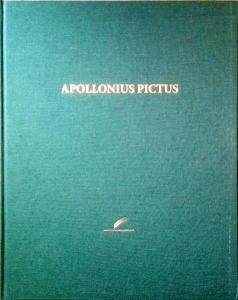
Apollonius Pictus
Apollonius Pictus
An illustrated romance from Late Antiquity (cca. 1000 AD.)
Facsimile edition of Historia Apollonii regis Tyri (NSZL, Cod. Lat. 4.)
Edited by Anna Boreczky
NSZL, Budapest, 2011, 184 pages + 8 pages of attachments
ISBN 978 963 200 600 0
One of NSZL’s oldest manuscripts, Cod. Lat. 4, is an „adventure romance” of Late Antiquity: the history of Apollonius, King of Tyre. The novella enjoyed great popularity in the Middle Ages, and inspired several later literary works, including William Shakespeare’s Pericles. Apart from the text, the manuscript contains 38 uncolored ink drawings that place it at the level of the earliest remained illustrated copies of the work. The text is the oldest and most important piece of a text variant of the novella, and yet the manuscript has been almost entirely hidden so far from the experts of the field.
The parchment manuscript was made in the changing world of the first millennium. It adapts the antique traditions to the spirit of Christianity in line with the colorful Europe taking shape around the year 1000 characterized by both tradition and renewal. The work was copied in the Benedictine monastery of Werden an der Ruhr, located in the Cologne Archdiocese.
The accompanying illustrations bear characteristics of the original antique cycle of illustrations (lost by now), thus provide essential information on the art of books in Late Antiquity. They deserve a special place also in the history of secular narrative picture series, and can be regarded as the predecessors of today’s comics. Within the ecclesiastical book culture of the Ottonian period when they were made, they are really unique.
Next to the drawings, there are several German names written with 11-12th century German style: the names of the users. The manuscript remained in the Werden monastery probably until the second half of the 15th century, then it became the property of a professor in Cologne. In the 18th century as the latest, it already belonged to the library of the Sopron Evangelical Convent that in 1814 donated it to National Széchényi Library.
On the 8th of December 2010, Romanesque art researcher Professor Dr. Xavier Barral i Altet and two NSZL specialists of the manuscript (Anna Boreczky and András Németh) presented the codex to a circle of experts, in a symposium organized by Collegium Budapest and NSZL. Then we started the preparatory work on the facsimile edition and the accompanying collection of essays. The latter is a multilingual collection of the contributions of international experts who present the history of the manuscript, its significance in art history, and the linguistic specialties of the text. It includes the recommendation by Prof. Ernő Marosi, the essays by Xavier Barral i Altet, Anna Boreczky, Kessler Herbert L., András Németh, Andreas Nievergelt, and Beatrice Radden Keefe in English, German and French, with pictures and a summary in Hungarian. We also publish the bilingual (English and Hungarian) description of the basic data of the manuscript, the scenes of the cycle of illustrations and the critical transcription of the text variant. All these details serve the purpose that the work is given its deserved place in the knowledge of the academic world.
Shopping
Our publications are available in our bookshop, or can be ordered from the Publications Department of the NSZL using the contact details below: Főigazgatói Kabinet kiadványtára, Országos Széchényi Könyvtár, 1276 Budapest P.O. box 1205., phone: 06 1 232-3556, e-mail: kiadvanytar@oszk.hu.




